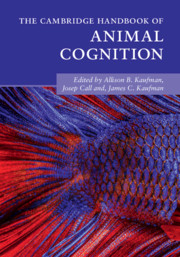Book contents
- The Cambridge Handbook of Animal Cognition
- The Cambridge Handbook of Animal Cognition
- Copyright page
- Dedication
- Contents
- Figures, Tables, and Boxes
- Contributors
- Acknowledgments
- Introduction
- Part I Communication and Language
- Part II Memory and Recall
- Part III Social Cognition
- 11 Social Cognition Overview
- 12 Proximate and Ultimate Mechanisms of Cooperation in Fishes
- 13 Evolutionary and Neural Bases of the Sense of Animacy
- 14 Raven Social Cognition and Behavior
- 15 Reciprocal cooperation – Norway rats (Rattus norvegicus) as an example
- 16 Exploring the Social Minds of Elephants
- 17 Dolphin Social Cognition
- 18 Mirror Self-Recognition
- Part IV Social Learning and Teaching
- Part V Numerical and Quantitative Abilities
- Part VI Innovation and Problem-Solving
- Index
- References
17 - Dolphin Social Cognition
from Part III - Social Cognition
Published online by Cambridge University Press: 01 July 2021
- The Cambridge Handbook of Animal Cognition
- The Cambridge Handbook of Animal Cognition
- Copyright page
- Dedication
- Contents
- Figures, Tables, and Boxes
- Contributors
- Acknowledgments
- Introduction
- Part I Communication and Language
- Part II Memory and Recall
- Part III Social Cognition
- 11 Social Cognition Overview
- 12 Proximate and Ultimate Mechanisms of Cooperation in Fishes
- 13 Evolutionary and Neural Bases of the Sense of Animacy
- 14 Raven Social Cognition and Behavior
- 15 Reciprocal cooperation – Norway rats (Rattus norvegicus) as an example
- 16 Exploring the Social Minds of Elephants
- 17 Dolphin Social Cognition
- 18 Mirror Self-Recognition
- Part IV Social Learning and Teaching
- Part V Numerical and Quantitative Abilities
- Part VI Innovation and Problem-Solving
- Index
- References
Summary
Bottlenose dolphins are a large-brained, long-lived, highly social species, operating within a fission-fusion society characterized by broad multi-level social networks, extensive care giving and teaching of offspring, cooperative and diverse hunting tactics, long-term alliances, and learned vocal signals that broadcast an individual’s identity, can be used in referential exchanges and can be imitated by close associates.Observations of behavior and social interactions in the wild suggest that social cognition in the bottlenose dolphins is well developed.Over the past thrity years, experimental studies have revealed that bottlenose dolphins have decades long social memories of associates, can develop a broad concept of imitation that extends to arbitrary novel sounds and social behaviors presented in a variety of contexts as well as to self-initiated behaviors.Dolphins have also been shown to be able to learn about and appreciate the social requisites of cooperative behavior, can spontaneously understand the referential character of human-initiated social signals involving pointing and gazing, and can employ pointing productively in communicative exchanges with humans to achieve goals.Collectively, dolphin social-cognition abilities are sophisticated and similar in several aspects to those of other species living within complex social networks, such as elephants, chimpanzees, and humans.
Keywords
- Type
- Chapter
- Information
- The Cambridge Handbook of Animal Cognition , pp. 383 - 414Publisher: Cambridge University PressPrint publication year: 2021
References
- 1
- Cited by

